Abstract
With over 50% of the US population living in coastal counties, the ocean and coastal environments have substantial impacts on coastal communities. While may of the impacts are positive, such as tourism and recreation opportunities, there are also negative impacts, such as exposure to harmful algal blooms (HABs) and water borne pathogens. Recent advances in environmental monitoring and weather prediction may allow us to forecast these potential adverse effects and thus mitigate the negative impact from coastal environmental threats.
One example of the need to mitigate adverse environmental impacts occurs on Florida’s west coast, which experiences annual blooms, or periods of exuberant growth, of the toxic dinoflagellate, Karenia brevis. K. brevis produces a suite of potent neurotoxins called brevetoxins. Wind and wave action can break up the cells, releasing toxin that can then become part of the marine aerosol or sea spray. Brevetoxins in the aerosol cause respiratory irritation in people who inhale it. In addition, asthmatics who inhale the toxins report increase upper and lower airway lower symptoms and experience measurable changes in pulmonary function. Real-time reporting of the presence or absence of these toxic aerosols will allow asthmatics and local coastal residents to make informed decisions about their personal exposures, thus adding to their quality of life.
A system to protect public health that combines information collected by an Integrated Ocean Observing System (IOOS) has been designed and implemented in Sarasota and Manatee Counties, Florida. This system is based on real-time reports from lifeguards at the eight public beaches. The lifeguards provide periodic subjective reports of the amount of dead fish on the beach, apparent level of respiratory irritation among beach-goers, water color, wind direction, surf condition, and the beach warning flag they are flying.
A key component in the design of the observing system was an easy reporting pathway for the lifeguards to minimize the amount of time away from their primary duties. Specifically, we provided a Personal Digital Assistant for each of the eight beaches. The portable unit allows the lifeguards to report from their guard tower. The data are transferred via wireless Internet to a website hosted on the Mote Marine Laboratory Sarasota Operations of the Coastal Ocean Observation Laboratories (SO COOL) server.
The system has proven to be robust and well received by the public. The system has reported variability from beach to beach and has provided vital information to users to minimize their exposure to toxic marine aerosols.
Keywords: asthma, Florida red tide, Harmful algal blooms, ocean observing systems, beach conditions, Karenia brevis
Introduction
With over 50% of the US population living in a coastal county, the potential impacts the ocean and coastal environments have on people are substantial. Florida has experienced the greatest percent coastal population growth between 1980 and 2003, reaching nearly 75 percent (Crossett et al., 2004). These impacts are both positive (such as tourism and recreational opportunities), as well as negative (such as exposure to marine toxins and pathogens and extreme weather events). Florida is the top travel destination in the world with 76.8 million visitors in 2004 (a record number). The tourism industry has an economic impact of $57 billion on Florida’s economy (VISIT FLORIDA Research, 2007).
Epidemiologic studies to identify populations at risk from these ocean-related hazards, such as marine toxins, pathogens, and extreme weather events are needed. In addition, the public also needs “real-time” data to make educated decisions regarding their exposure to these marine hazards (HARRNESS, 2005). As we continue to populate our coastlines, potentially exposing increased numbers of people to ocean-borne health hazards, the development of an Integrated Ocean Observing System (IOOS) that reports and forecasts coastal health risks is essential to protect public health (Ocean. US, 2006).
The Florida west coast is an example of a geographic area in need of real-time public health information from an IOOS specifically for harmful algal blooms (HABs). Florida’s west coast experiences annual blooms of the toxic dinoflagellate, Karenia brevis This dinoflagellate is a single cell marine plankton. It is photosynthetic and is a primary producer in the food web. K. brevis produces a suite of potent neurotoxins, brevetoxins, which kill fish; sicken marine mammals, sea turtles, and sea birds; and cause neurotoxic shellfish poisoning (NSP) in people who eat contaminated shellfish (Baden, 1983; Kirkpatrick et al., 2004). In addition, because K. brevis is an unarmored dinoflagellate, the cells lyse easily, thereby releasing toxins into the water. Wind and wave action then cause the toxins to become part of the marine aerosol or sea spray (Pierce et al., 1989, 1990), which can induce respiratory irritation as people inhale the toxic particles (Woodcock, 1948). Backer et al. (2003) demonstrated that recreational beach goers exposed to Florida red tides experienced respiratory symptoms such as eye irritation, nasal congestion, and a dry cough. Lifeguards occupationally exposed to Florida red tides also experienced similar respiratory symptoms (Backer et al., 2005). More recently, Fleming et al. (2005, 2007) documented increases in upper (eye irritation, nasal congestion, and a dry cough ) and lower (chest tightness and wheezing) airway symptoms and changes in airflow measurements in an asthmatic cohort after a 1-hour beach exposure to the airborne brevetoxins. In addition, the asthmatic subjects reported that symptoms persisted for several days after the beach exposure (Kirkpatrick et al., in press). Furthermore, in a retrospective study examining emergency room admissions at a coastal hospital, it was found that coastal residents had a 54% increase in admissions for respiratory diagnosis (i.e. asthma, pneumonia, and bronchitis) during an onshore red tide compared to when there was no red tide (Kirkpatrick et al., 2006). The incidence of asthma in the US is approximately 10% and has been on the increase over recent years (Gold and Wright, 2005). Therefore, the numbers of persons of all ages potentially at risk for prolonged effects from occupational and environmental exposure to the Florida red tide aerosolized toxins are significant and growing. There is an increased need for all coastal residents to know when there are high toxin conditions so they can minimize their exposure to these toxic aerosols.
Several methods have been employed over the years to monitor K. brevis blooms and the toxic aerosols from the blooms. The State of Florida maintains an aggressive monitoring program of coastal and marine waters for K. brevis blooms, primarily to protect the shellfish harvest. These data have not been used to protect or warn persons about potential aerosol exposures. The primary standard for monitoring and reporting is by cell count of the numbers of K. brevis organisms in water samples using a microscope. This method is extremely accurate but also extremely labor intensive. Depending on the number of samples collected, it may take several days before results are reported. Florida red tides are often very patchy as currents move the bloom up and down the coastline (Stumpf et al., 2003), therefore cell count data that are several days old are not a useful indicator of current local conditions. In addition, although cell counts are an indication of the bloom intensity, other factors (such as wind and wave action) determine the amount of brevetoxins in the water and in aerosols (Pierce et al., 2003). Current methods for airborne and water toxin analysis are by high performance liquid chromatography/mass spectrophotometry (HPLC/MS) and enzyme-linked immunosorbant assay (ELISA). However, these methods are used primarily for research studies, not for routine environmental monitoring. As with the cell counts, these methods are extremely accurate but there is a substantial delay from the time the sample is taken to the reporting of results. The need for real-time cell count and toxin analyses has been cited by several working groups (HARRNESS, 2005; Ocean. US, 2006). Regardless, these raw data are not as important to the local residents and tourist communities who want to know if it is a good day to go to the beach and/or whether it is safe to participate in outdoor activities in their coastal community.
Based on current and historical remote sensing (chlorophyll detection of blooms), oceanographic (current and wind) data, and on-the-ground cell count monitoring, the NOAA HAB Bulletin (http://coastwatch.noaa.gov/hab/bulletins_ns.htm) currently supplies information regarding current and forecast bloom location, extent and possible development or movement. Additional analyses (such as possible coastal impacts) are provided to state and local resource managers; this information is in developmental stage, and currently not offered in real-time to the public.
Since 80% of people who visit Florida cite the beach as their primary reason to visit (VISIT FLORIDA Research, 2007) its important that tourist communities affected by Florida red tide have the tools to provide the best beach experience possible for their visitors. With the patchiness of these Florida red tides, this may mean informing visitors that although current conditions at the closest beach may not be optimal, conditions on beaches to the north or south by just a few miles may be acceptable. A National Oceanographic Partnership Program (NOPP) study estimated that a regional IOOS could result in increased revenues from beach recreation (due to fewer lost days and improved safety) by $50 million in Florida alone (Kite-Powell et al., 2005). Reporting real-time beach conditions, including indications of the presence of toxic aerosols, can improve the quality of life for the local community as well as visitors, and, in particular, for asthmatics and their families.
Methods
Environmental and health data
As an IOOS Public Health Pilot Study in HABs, a real-time beach conditions reporting system has been designed and implemented in Sarasota and Manatee Counties (Florida) (http://coolgate.mote.org/beachconditions/). This system is based on “Condition Reports” from lifeguards at the eight public beaches in these two counties on Florida’s west coast (see map, Figure 1). The arrows in the inset indicate the furthest reporting points to the north, Manatee Beach and to the south, Manasota Beach. Individually, the longest beach is 1.4 miles and the shortest beach is 0.5 miles. These beaches were chosen because they were well attended (i.e., weekend day attendance on a warm, sunny day can total over 20,000 people). These beaches span 30 miles on a series of barrier islands, and thus experience varying environmental conditions. The Counties staff these beaches with year round, 7 day/week, full-time lifeguards, making these beaches ideal areas to assess the importance of changing beach conditions on public health. For the condition reports, lifeguards provide subjective reports of the following: the level of respiratory irritation among beach-goers, the amount of dead fish on the beach, water color, wind direction, and surf conditions (all factors usually associated with increased brevetoxin-associated aerosols in coastal communities during K. brevis blooms). In addition, the lifeguards record the status of the Florida beach warning flag for surf, currents, and other marine hazards (see Figure 2).
Figure 1.
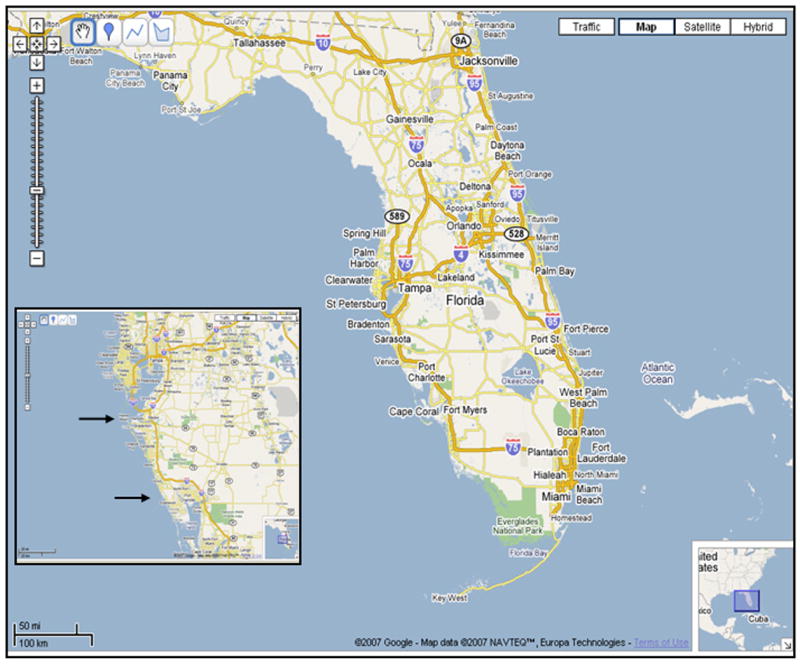
Site Location
Figure 2.
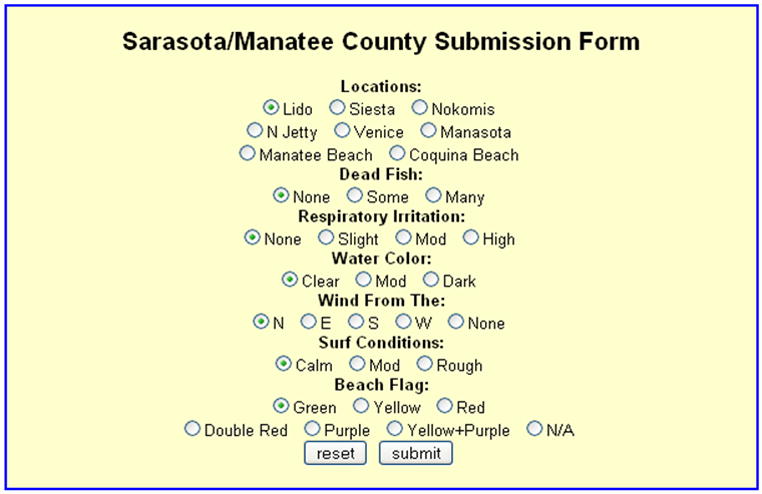
Lifeguard Submission Report
Reporting mechanism
A key component in the design of the Pilot Public Health IOOS was an easy reporting pathway for the lifeguards to minimize the amount of time away from their primary duties. The system provides a personal digital assistant (PDA) (Blackberry #7250) for each of the eight beaches. The portable, battery powered unit allows the lifeguards to take the unit to their beach guard tower. As conditions change, they can input the data easily on site through a wireless web-based connection to the Conditions Report database at Mote Marine Laboratory.
Lifeguards were individually instructed in the data input procedures, and provided with a rubric for each of the reporting criteria. Step-by-step written instructions were also provided as an insert in the unit’s storage case, along with a phone number for assistance. Guards were asked to provide beach conditions at the start of their shift (10 am) and mid shift at 3 pm. If environmental conditions changed during the day, they were encouraged to file interim reports.
The data were automatically transferred via wireless internet to a website hosted on the Mote Marine Laboratory (MML) Sarasota Operations of the Coastal Ocean Observation Laboratories (SO COOL) server (http://coolgate.mote.org/beachconditions/). The output was displayed on a Google Earth map (see Figure 3). The user selected the beach of interest, and a “pop up window” provided the most recent report for that beach with a date and time stamp. To reach people who may not be connected to the Internet, an automated voice system automatically transferred the data into a telephone message (tel: 941-388-5223). All data are archived into an easily searchable database. A voluntary Satisfaction Survey was added to the site in mid-October 2006.
Figure 3.
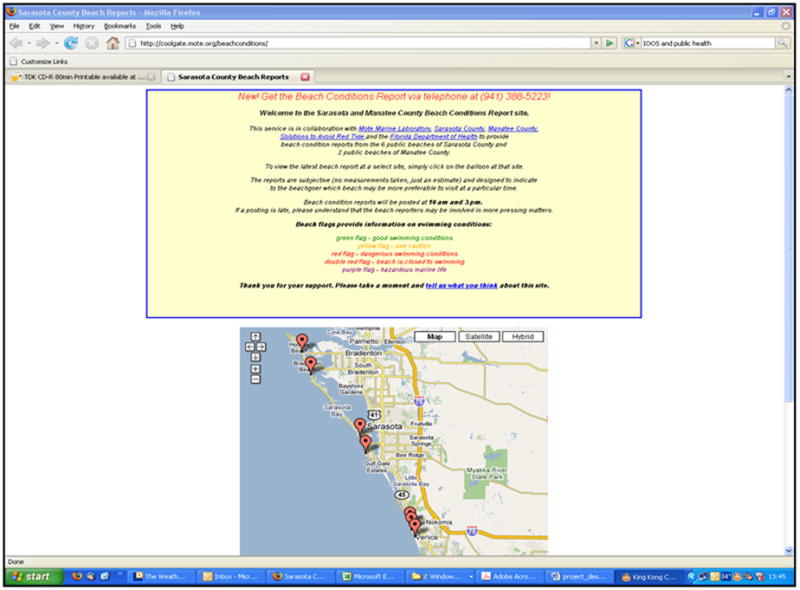
Splash Page
The area was experiencing a K. brevis bloom for approximately 3 months at the time of implementation of the reporting system on the first Friday in September 2006, in concert with Labor Day weekend. A media release from Mote Marine Laboratory’s Communications Department was disseminated to approximately 75 local media outlets from the St Petersburg to Fort Myers area, Due to the presence of a current red tide, media response was excellent and numerous television and newspaper articles announced the implementation of the system. To further disseminate the system to the public, links on Florida red tide partner websites were established ( such as Florida Department of Health Aquatic Toxins Program, the Sarasota and Manatee Counties Health Departments, and the University of Miami Marine and Freshwater Toxin Hotline Program).
Results
During the first month the system was operational, the website received over 85,000 hits. In addition, Mote Marine Laboratory received numerous telephone calls from the public reporting their appreciation for the system. The lifeguards and the counties governments were very supportive of the system. In a retrospective analysis or reporting frequency, daily reports were received 96% of the time in the first year and 2 or more reports were provided 80% of the time.
The PDA’s proved to be a robust reporting tool with no unit failures over the course of the year. Only minor troubleshooting issues that proved to be user errors were reported. In the first few months of operation, MML staff checked the site for a daily report from each site and personally called the lifeguards and reminded them to file a report. After several months of operation, reporting became more consistent.
Examples of the effectiveness of the system are shown in Figures 4 and 5. Note that in Figure 4, Venice Beach reported high respiratory irritation. In Figure 5, Siesta Key filed a report within 2 minutes of the Venice report with no respiratory irritation. If users checked the website (or hotline) prior to leaving for the beach, they could choose to visit Siesta Key Beach, and minimize any effects from airborne toxins.
Figure 4.
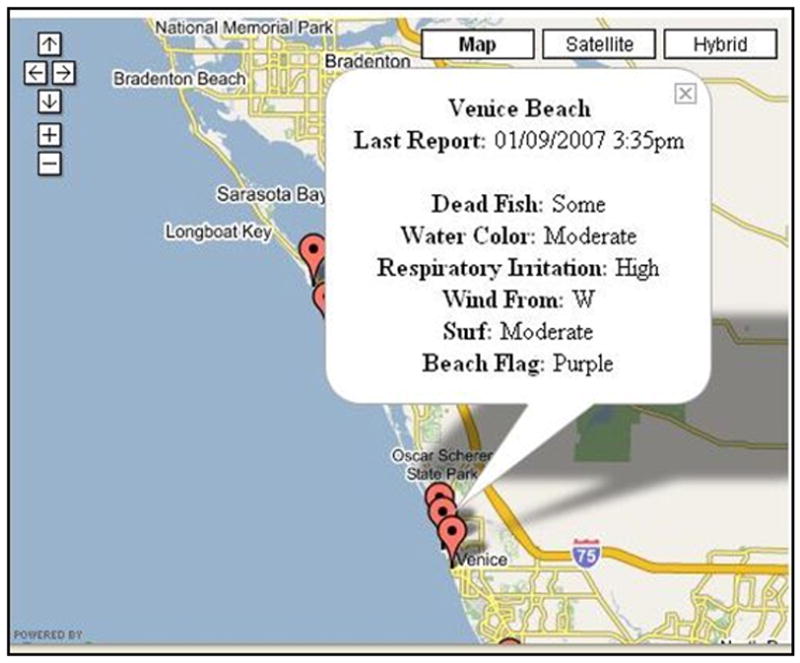
Venice Beach Report
Figure 5.
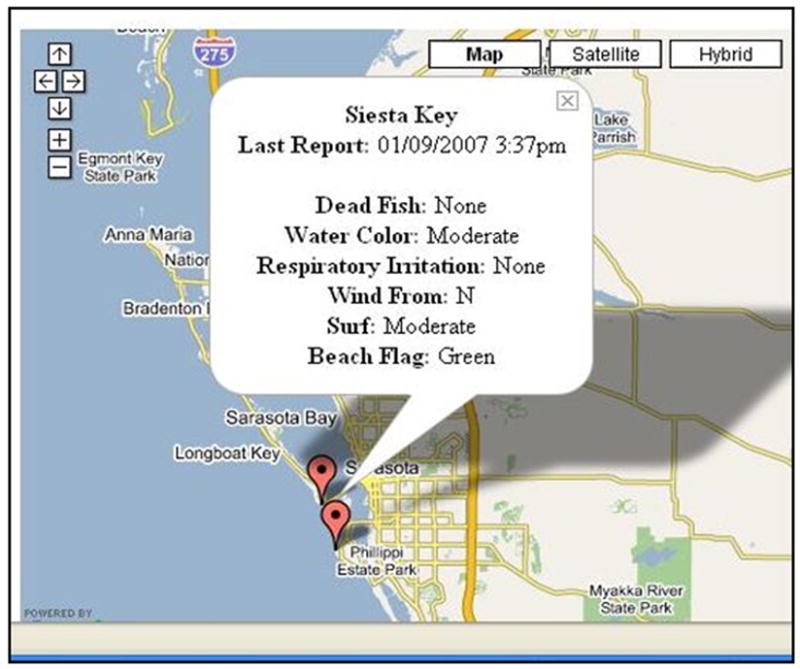
Siesta Key Beach Report
In the Satisfaction Survey, the following two questions were asked: 1) Was this beach report helpful to you? (with the response a modified Likert scale), and 2) Would you like to see reports all year, even when there isn’t a red tide bloom? (yes or no). Among the 176 persons who have responded to the survey, 94 % have stated that the site is very helpful and 98% preferred that the System remain active throughout the year. In addition, anecdotal telephone reports indicated that people are using the information on the website for a variety of decision-making issues, including finding the best waves for surfing and avoiding areas with strong waves that might be dangerous for small children.
Discussion
With recent studies identifying the harmful effects from the toxic K. brevis aerosols, there is a need to provide the public with real-time beach conditions reports so they can make informed, educated decisions regarding their recreation at the beach. Although analytical toxin measurement in real-time would be ideal, the methodology is not currently available. In addition, even if this information were available in real time, the general public would have difficulty accurately interpreting cell counts, toxin levels, or satellite imagery. Several studies recently have demonstrated that people are sensitive to these airborne toxins, exhibiting respiratory irritation, and as a result, subjective reports are good proxies to objective air data. The Pilot Public Health IOOS Beach Conditions Reporting System provides subjective but real-time condition reports using a methodology with simple data input and easy to access results. It is focused primarily on issues important to beach visitors: safety and public health.
These data, particularly the respiratory irritation information, are also being used by the NOAA HAB Bulletin group for improving their model’s forecasting and hindcasting abilities. An analysis of the beach reports compared to the HAB Bulletin conditions and forecasts is currently underway. The ultimate goal of both programs is to provide the public not only with the current conditions at public beaches, but also a forecast of what the beach conditions will be in 48–72 hours, allowing people to make informed decisions on weekend activities, planned events such as outdoor beach weddings or birthday parties.
In the Ocean US Public Health Workshop Report (Ocean. US, 2006), critical components cited for the success of the Report’s Recommendations are new collaborations across multiple disciplines, more effective use of the internet and other electronic media to transmit relevant public health data, and promotion of stronger stakeholder coordination. This Reporting System demonstrates the implementation and success of all of these components. The US Commission on Ocean Policy (2004) calls for an Ocean Observing System (OOS). Benefits cited from an OOS are protecting human lives and livelihoods from marine hazards, educating the public about the role and importance of the oceans in daily life, and providing for the sustainable use, protection, and enjoyment of ocean resources. The Public Health Pilot Study in HABs addresses these benefits in a real time, easily interpretable format making it the first public health IOOS.
Limitations
The primary limitation of this beach conditions reporting system is the funding to maintain it. Each PDA has a monthly service fee for Internet access. After initial implementation, personnel time to train new employees/lifeguards and respond to trouble/help calls is needed as well as database maintenance. Although these costs are minimal when compared to the costs associated with a traditional monitoring program using cell counts, they are still vital to the sustainability of the system.
The other limitation that may preclude the system from being a statewide or nationwide program is the availability of beach sentinels in all communities. Many communities are not as fortunate as Manatee and Sarasota Counties to have professional, year round lifeguards on their public beaches and other strategies may have to be explored to expand into other counties.
Conclusion
The Pilot Public Health IOOS Beach Conditions Reporting System is an effective method to report Florida red tide impacts on beaches to the general public. The real-time data allows beach goers to assess daily conditions and make informed decisions regarding personal exposures to the toxic aerosols and risks to their health. Although the traditional concept of an IOOS may be the implementation of sensors in the water to provide real-time objective data, this reporting system demonstrates the utility of using lifeguards as sentinels and the value of using subjective data.
Acknowledgments
We would like to thank the lifeguards of Sarasota and Manatee Counties who gladly take the time every day to participate in this ocean observing system, and for their dedication and love for the beach and our oceans.
This research was supported by the Centers for Disease Control and Prevention and the Florida Department of Health (Cooperative Agreement: U50/CCU423360-02) as well as by the P01 ES 10594 of the National Institute of Environmental Health Sciences (NIEHS). The beach conditions reporting system is US Patent Pending.
Footnotes
Publisher's Disclaimer: This is a PDF file of an unedited manuscript that has been accepted for publication. As a service to our customers we are providing this early version of the manuscript. The manuscript will undergo copyediting, typesetting, and review of the resulting proof before it is published in its final citable form. Please note that during the production process errors may be discovered which could affect the content, and all legal disclaimers that apply to the journal pertain.
References
- Backer LC, Fleming LE, Rowan R, Cheng YS, Benson J, Pierce R, Zaias J, Bean J, Bossart R, Johson D, Quimbo R, Baden D. Recreational exposure to aerosolized brevetoxins during Florida red tide events. Harmful Algae. 2003;2:19–28. [Google Scholar]
- Backer LC, Kirkpatrick B, Fleming LE, Cheng YS, Pierce R, Bean JA, Clark R, Johnson D, Wanner A, Tamer R, Zhou Y, Baden D. Occupational exposure to aerosolized brevetoxins during Florida red tide events: effects on a healthy worker population. Environ Health Perspect. 2005;113(5):644–9. doi: 10.1289/ehp.7502. [DOI] [PMC free article] [PubMed] [Google Scholar]
- Baden DG. Marine food borne dinoflagellates toxins. Int Review Cytol. 1983;82:99–150. doi: 10.1016/s0074-7696(08)60824-4. [DOI] [PubMed] [Google Scholar]
- Crossett KM, Culliton TJ, Wiley PC, Goodspeed TR. Populations Trends along the Coastal United States: 1980–2008. National Oceanographic and Atmospheric Administration, NOAA’s National Ocean Service, Special Projects; Silver Spring, MD: 2004. pp. 1–54. [Google Scholar]
- Fleming LE, Kirkpatrick B, Backer LC, Bean JA, Wanner A, Dalpra D, Tamer R, Zaias J, Cheng YS, Pierce R, Naar J, Abraham W, Clark R, Zhou Y, Henry MS, Johnson D, Bogart G, Bossart GD, Harrington M. Initial evaluation of the effects of aerosolized Florida red tide toxins (brevetoxins) in persons with asthma. Environ Health Perspect. 2005;113(5):650–7. doi: 10.1289/ehp.7500. [DOI] [PMC free article] [PubMed] [Google Scholar]
- Fleming LE, Kirkpatrick B, Backer LC, Bean JA, Wanner A, Reich A, Dalpra D, Zaias J, Cheng YS, Pierce R, Naar J, Abraham WM, Baden DG. Aerosolized red-tide toxins (brevetoxins) and asthma. Chest. 2007;131(1):187–94. doi: 10.1378/chest.06-1830. [DOI] [PMC free article] [PubMed] [Google Scholar]
- Gold DR, Wright R. Population disparities in asthma. Annu Rev Public Health. 2005;26:89–113. doi: 10.1146/annurev.publhealth.26.021304.144528. [DOI] [PubMed] [Google Scholar]
- Rasmdell JS, Anderson DM, Glibert PM, editors. HARRNESS. Harmful Algal Research and Response: A National Environmental Science Strategy 2005 – 2015. Ecological Society of America; Washington, DC: 2005. p. 96. [Google Scholar]
- Kirkpatrick B, Fleming LE, Squicciarini D, Backer LC, Clark R, Abraham W, Benson J, Cheng YS, Johnson D, Pierce R, Zaias J, Bossart GD, Baden DG. Literature review of Florida red tide: implications for human health effects. Harmful Algae. 2004;3(2):99–115. doi: 10.1016/j.hal.2003.08.005. [DOI] [PMC free article] [PubMed] [Google Scholar]
- Kirkpatrick B, Fleming LE, Backer LC, Bean JA, Tamer R, Kirkpatrick G, Kane T, Wanner A, Dalpra D, Reich A, Baden DG. Environmental exposures to Florida red tides: effects on emergency room respiratory diagnoses admissions. Harmful Algae. 2006;5:526–33. doi: 10.1016/j.hal.2005.09.004. [DOI] [PMC free article] [PubMed] [Google Scholar]
- Kirkpatrick B, Bean J, Fleming LE, Backer LC, Akers R, Wanner A, Dalpra D, Nierenberg K, Reich A, Baden D. Aerosolized Red Tide Toxins (Brevetoxins) and Asthma: A 10 day follow up after 1 hour acute beach exposure. In: Moestrup, et al., editors. Proceedings of the 12th International Conference on Harmful Algae; International Society for Harmful Algae and Intergovernmental Oceanographic Commission of UNESCO. in press. [Google Scholar]
- Kite-Powell HL, Colgan CS, Wellman KF, Pelosci T, Wieand K, Pendleton L, Kaiser MJ, Pulsipher AG, Luger M. Estimating the Economic Benefits of Regional Ocean Observing Systems. Woods Hole Oceanographic Institution Technical Report; Woods Hole, MA. 2005. [Google Scholar]
- Ocean. US. Public Health Risks: Coastal Observations for Decision-Making. Publication No. 15; Arlington, VA. 2006. p. 40. [Google Scholar]
- Pierce R, Henry M, Boggess S, Rule A. Marine toxins in bubble-generated aerosol. In: Monahan E, Van Patton P, editors. The Climate and Health Implications of Bubble-Mediated Sea-Air Exchange; Connecticut Sea Grant Publications; 1989. pp. 27–42. [Google Scholar]
- Pierce RH, Henry MS, Proffitt LS, Hasbrouck PA. Red tide toxin (brevetoxin) enrichment in marine aerosol. In: Graneli E, Sundstron S, Elder L, Anderson DM, editors. Toxic Marine Phytoplankton. 1990. pp. 397–402. [Google Scholar]
- Pierce RH, Henry MS, Blum PC, Lyons J, Cheng YS, Yazzle D, Zhou Y. Brevetoxin concentrations in marine aerosol: human exposure levels during a K.brevis harmful algal bloom. Bull Environ Contam Toxicol. 2003;70(1):161–165. doi: 10.1007/s00128-002-0170-y. [DOI] [PMC free article] [PubMed] [Google Scholar]
- State of Florida. Department of ;2007. July.
- Stumpf RP, Culver ME, Tester PA, Tomlinson M, Kirkpatrick GJ, Pederson BA, Truby E, Ransibrahmanakul V, Soracco M. Monitoring Karenia brevis blooms in the Gulf of Mexico using satellite ocean color imagery and other data. Harmful Algae. 2003;2(2):147–60. 2003. [Google Scholar]
- U.S. Commission on Ocean Policy. An Ocean Blueprint for the 21st Century. Final Report. Washington, DC, 2004 ISBN#0–9759462–0–X.
- Woodcock AH. Note concerning human respiratory irritation associated with high concentrations of plankton and mass mortality of marine organisms. J Marine Res. 1948;7:56–62. [Google Scholar]
- VISIT FLORIDA Research. 2007 http://media.visitflorida.com/about/research/


